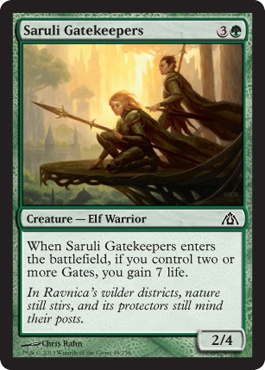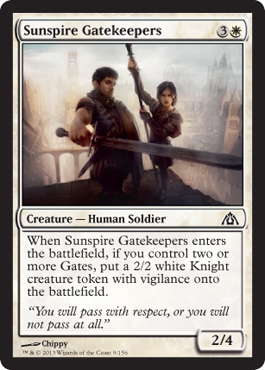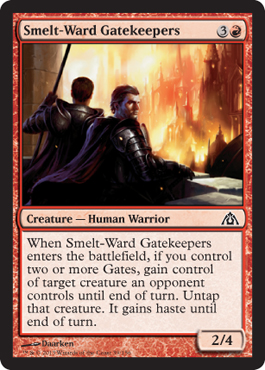Last week we reflected on the past. This week we’ll dive ahead into the future. What will drafting Dragon’s Maze–Gatecrash–Return to Ravnica be like?
We’re in the middle of spoiler season. Wizards likes to kick things off with a bang and get everyone excited for all of the rares and mythics people will dream of cracking. Any such card could be a new Constructed powerhouse. However, I’m a Limited player. I want to know what the new draft format’s going to look like! Sadly, it’s not until the set gets fully spoiled that we get a good look at the most important cards for Limited: commons!
If you frequent Magic websites, you’re likely aware that Conley Woods of ChannelFireball has already written an excellent article on DGM Limited. Rather than be redundant, I’m going to focus on something which Mr. Woods did not: the six common creatures spoiled last week.
As of April 14, we know six common creatures: Deputy of Acquittals and the five mono-color Gatekeepers.
I’ll start with Deputy of Acquittals, the only card not in the gatekeeper cycle. I love the design here—it’s a bear with two abilities that make it extremely flexible. Sure, we’ve seen a similar effect before in Whitemane Lion, but the second ability now having a “may” clause opens a lot of space. (I acknowledge the Deputy’s inability to bounce itself makes it worse than Whitemane Lion for storm decks, but that archetype doesn’t exist in DGM… or ever will again, if Mark Rosewater’s “Storm Scale” is to be believed.)
Deputy of Acquittals can be a Counterspell. It protects a creature you control from a removal spell.
Deputy of Acquittals can be a Restoration Angel. It helps reuse enters/leaves the battlefield effects.
Deputy of Acquittals can be an Ambush Viper. It shows up in the middle of combat and trades with your opponent’s creature (or eats an attacking Bomber Corps).
I’m not saying that Deputy of Acquittals is as powerful as Restoration Angel, as lethal as Ambush Viper, or anywhere close to being an actual Counterspell. I’m saying that the card is flexible. It offers many things in a discreet package (like some other cards). It’s also a 2/2 for two mana—which was a really good thing in Gatecrash Limited. In Return to Ravnica, Faerie Imposter used a similar “gating” ability to reuse Azorius Justiciar and Voidwielder to great effect. Deputy of Acquittals offers to fill multiple roles, and any card that gives you more options warrants consideration. What roles need be filled, only further spoilers will tell, but I’m looking forward to flashing in the new Ashcoat Bear.
Dragon’s Maze also introduces a cycle of five “gatekeepers,” one for each color. Each is a splashable 2/4 for four mana. Each has an enters-the-battlefield (ETB) effect which triggers if you control two or more gates. Each is a common in a small set, so you’re likely to see multiple gatekeepers in a DGM draft. To evaluate these cards, I ask four questions:
1. Is a 2/4 for four mana good?
This depends on the format. A 2/4 is very good at stopping small, aggressive creatures like Wojek Halberdiers and Gore-House Chainwalker. Scab-Clan Charger and an evolved Crocanura were adept at stymieing aggressive starts in Gatecrash (where 2/2s were good and frequently on the battlefield). I have less fond memories of Return to Ravnica’s Towering Indrik, where cards like Centaur Healer, Sunspire Griffin, and Splatter Thug had three toughness, cost one mana less than the Indrik, and attacked freely into 2/4s.
Whether 2/4 is a good body depends on how often creatures are expected to be attacking and how large those creatures are. If 2/2s are attacking, then a 2/4 will be a great blocker. If 3/3s for three mana are attacking, then a 2/4 for four mana will be a slow, inefficient blocker. If the format will be slow and grindy, where players don’t attack until they find their best cards, then the body will be largely irrelevant.
2. Would you play this card without its ETB effect?
This question relates directly to the previous one. If a 2/4 for four is good, then the ETB effect is gravy on an already serviceable creature. If a 2/4 for four is horrid, then the ETB effect is the only thing that justifies putting the card in your deck. These cards are likely somewhere between these two extremes.
3. How good is the ETB effect?
Each gatekeeper has an ETB effect that can be compared to another Magic card. Sunspire Gatekeepers provides a 2/2 white Knight token with vigilance (a mode of Selensya Charm). Opal Lake Gatekeepers draws a card—something usually worth two mana (see Twiddle and Twitch). Ubal Sar Gatekeepers provides a Disfigure. Smelt-Ward Gatekeepers gives you most of a Threaten (it can’t affect your own creatures to untap them or give them haste), while Saruli Gatekeepers provides a Heroes’ Reunion. Interestingly, most of these effects cost about two mana (Ubal Sar’s costs one and Smelt-Ward’s costs three).
Sunspire Gatekeepers has the potential to provide four power and six toughness for the discount price of four mana. A 4/6 for four mana is nothing to sneer about. And getting two creatures for the price of one is great with effects like Honor of the Pure and Cathars’ Crusade. If you need to stabilize against an aggressive start or want to start getting aggressive yourself, getting two creatures and four power for four mana will be very helpful.
This card is reminiscent of Ghalma’s Warden—the only other 2/4 for four mana that has the potential to be a 4/6. The Warden, however, was a weak card throughout Scars block Limited (which I wrote about last week). It was too slow against aggressive decks and too difficult to reliably make itself into a 4/6. I think that Sunspire Gatekeepers will be easier to trigger (since it’s not fighting for deck space with gates the way that artifacts and non-artifact creatures did in Scars block), but it could end up having similar problems to Ghalma’s Warden’s.
The other challenge of Sunspire Gatekeepers is that if a 2/4 for four mana is a good body (and will be frequently seen on the battlefield), then a 2/2 vigilant knight is a bad body (since it can’t attack into opposing 2/4s). On the other hand, if a 2/4 for four mana is a bad body because the format is really aggressive, then getting a knight token should be pretty good.
Opal Lake Gatekeepers is pretty self-explanatory. Drawing a card is great! It means that the creature is effectively “free” (minus the mana cost, of course), since you get to replace it with a fresh card immediately.
I wasn’t playing Magic when Rhox Meditant was in Limited, but I’ve heard that it wasn’t the easiest thing to trigger. Granted, for now I’m setting aside how easy it is to get the trigger and focusing only on the abilities. If you offer me a 2/4 for four that draws a card, I’ll happily jam it in my deck.
Ubul Sar Gatekeepers promises to kill a creature, and that’s a great thing. Sure, it can’t kill an Armada Wurm, but it will still have plenty of targets. The problem I foresee is the same problem that Sunspire Gatekeepers has: If the format is full of 2/4s and 3/3s (and 2/2s are bad), then Ubul Sar Gatekeepers might not be able to kill anything (without help). If 2/4s for four are slow creatures in a fast format, then Ubal Sar Gatekeepers will often kill an opposing creature.
Once again, the worse that a 2/4 for four mana is, the better that the ETB effect can be. This is great information, since either a 2/4 is good and the ETB effect is gravy; or a 2/4 is bad but the ETB effect justifies it; or the format is slow and grindy (wherein cards that can produce card advantage, like the gatekeepers, are better). There’s a great tension here and the gatekeepers have the potential to be useful in all three situations.
Smelt-Ward Gatekeepers gives you the most bang for your buck in terms of mana—Threaten is a three-mana ability, after all. However, putting an Act of Treason on a gatekeeper is odd, as 2/4 is a defensive body, and Act of Treason is a very aggressive card. All of the previous gatekeepers provided a direct form of card advantage, whereas Smelt-War Gatekeepers offers tempo advantage (or, if you have a way to sacrifice a creature, then Smelt-Ward Gatekeepers could help kill an enemy creature, as well).
This effect isn’t bad—anyone who played with or against Boros in a Gatecrash draft can attest to the power of Act of Treason. You get to take out a blocker, get another attacker, and likely trigger battalion, all in one card. Act of Treason could be terrible sometimes (such as when your opponent had a bunch of Corpse Blockades)—you wanted to cast it and win the game. If it were stapled onto a 2/4 body, you wouldn’t need to win the game immediately, since you’d get value that turn from stealing a creature and still have a gatekeeper. Imagine, however, if the format is slow and full of 2/4s and 3/3s. If you steal your opponent’s 3/3, it’ll just get blocked by a 2/4 (and your Threaten will have done nothing). If you’re playing against a slow deck with very few creatures and lots of removal spells, cluestones, and keyrunes, there might be no creature to steal. This ability, like Ubul Sar Gatekeepers’, has the potential to do nothing.
My biggest problem with this card is its the timeliness of its effect, but more on that at the end.
Saruli Gatekeepers is the second gatekeeper that provides tempo advantage in lieu of strict card advantage. Regular players know that cards like dedicated life-gain cards—like Demon’s Horn, Sacred Nectar, and Angel’s Mercy—are generally unplayable in Limited. Gnaw to the Bone is one of the only dedicated life-gain cards I know of that is Limited-playable (it both gains massive amounts of life and is a role player in the Spider Spawning draft deck).
But Saruli Gatekeepers is not a dedicated life-gain card. Like Lightning Helix and Centaur Healer, it is an incidental life-gain card. What that means is that you get a reasonable spell that has a free gift of some life. These effects are great! Zarichi Tiger is not an exciting card, but in Gatecrash Limited, it could beat aggro decks almost single-handedly. The Tiger pulled double duty—it would hold back a Firefist Striker or a Disiciple of the Old Ways while keeping your life total out of range of an Act of Treason or Boros Charm. If DGM is a very aggressive format, Saruli Gatekeepers could be amazing—getting a 2/4 blocker and seven life is like playing a Zarichi Tiger and activating it three and a half times that turn. On the other hand, if the format is slow and grindy, seven life shouldn’t do much against a late-game haymaker from your opponent—other than perhaps buy you a turn to draw an answer.
Time will tell how relevant incidental life gain is in DGM Limited, but I’m excited to have such a powerful option against aggressive decks.
4. How easy is it to get the ETB effect (on time)?
To get a gatekeeper’s ETB effect, you need to have at least two guildgates on the battlefield. In order to reliably get this trigger, you’ll need a bunch of guildgates in your deck. Let’s say having five to seven guildgates means you have reasonable chance of activating the gatekeeper by turn six (these numbers are estimates—there is no math to defend this supposition). It shouldn’t be too hard to draft this many guildgates, as each pack of DGM will contain a guildgate (or a shockland or Maze’s End), and of course you can snap up guildgates in the Gatecrash and Return to Ravnica packs as well. If you prioritize guildgates highly in draft, it should be easy to get enough to trigger your gatekeepers (and Ogre Jailbreakers).
There is an opportunity cost associated with having this many guildgates; guildgates are slow. Every turn that you play a gate, you are limited to the mana that was available to you last turn (plus the guildgate that you might have played the turn prior). If you’re playing a gatekeeper on turn four and getting its ETB effect, then you’ve already played a gate on two turns out of your first three. You’ve slowed down your deck in order to make your gatekeepers better. The previous paragraph suggested that it will be easy to get the ETB effect on time. Consider whether it will be easy—or advisable—to play a deck that’s slowed down by having lots of lands that come into play tapped.
In Return to Ravnica and Gatecrash, gates were generally low picks. Return to Ravnica was an aggressive format with a strong focus on being mono-guild. Gates often weren’t necessary, since most players were in two colors. Gatecrash had even faster and more focused decks—most notably, Boros (as well as the five-color gate deck, which did prioritize gates). In those Limited environments, playing a tapped land and restricting your ability to play spells was very dangerous. No cards exemplifies this more than Boros Guildgate.
I think it’s by far the worst guildgate. When playing a dedicated Boros draft deck, you want to curve out, using your mana as efficiently as possible every turn. If you don’t have a Boros Elite or a Foundry Street Denizen, then playing a Boros Guildgate on turn one has no opportunity cost. On any other turn, however, you must take time off to play Boros Guildgate—forcing your Daring Skyjek or Skyknight Legionnaire to come down a turn late. Slowing your deck down when you’re an aggressive deck with small battalion creatures is dangerous. Accordingly, I never want to have a Boros Guildgate in my Boros decks. I’ll put it in a slow Orzhov deck to help splash Assemble the Legion or toss it in a five-color Greenside Watcher deck, sure, but I’ll avoid Boros Guildgates like the Dakmor Plague.
In both RTR and Gatecrash limited, where I wanted to have an aggressive deck and avoid splashing a third color, I’d usually draft any playable card in my guild over a guildgate. The opportunity cost of having my lands come into play tapped was very high.
But if DGM draft encourages decks to have at least three colors—as it almost certainly will—then fixing will be important, the format will be slower (lands will ETB tapped, players will need more colored mana sources in order to cast their spells), and it will be easy for your deck to have the gates necessary to accommodate gatekeepers while remaining competitive.
I expect that Dragon’s Maze Limited will favor three-color-plus strategies. If you’re an Azorius or Golgari drafter, it behooves you to have a third color in order to draft powerful guilded cards in Gatecrash. I also expect that some mono-guild aggressive decks will continue to exist, notably Boros (which can pick up great red cards in Return to Ravnica). If the format is slow enough and the average decks have at least five gates, then gatekeepers will be great opportunities to get some card advantage …
… except for this one.
I’m sorry, Smelt-Ward Gatekeepers, but I think you’ve got the short end of the stick. Any deck that’s aggressive enough to want a Threaten is not going to want to play five or more gates, nor does such a deck want a vanilla 2/4 for four. You’ve got the potential to be a blowout, stealing an Utvara Hellkite or combining with Varolz, the Scar-Striped to sacrifice stolen creatures, but you’re just too slow to be a Threaten to the decks that want one. Maybe I’m wrong—perhaps you’re going to be great at stealing giant bombs in a format full of board stalls and dragons. Maybe there will be a three-color mid-range deck with Ogre Jailbreakers that would love another four-drop. But we won’t know that until we get to play with you.
Dragon’s Maze prerelease is next weekend and I encourage everyone to attend. (Here’s the link to pre-register at Twenty Sided Store.) Prereleases are exciting—you get to meet new people, run the Implicit Maze (this time around), and play with brand-new Magic cards! Maybe you’ll prove me wrong and demonstrate that Smelt-Ward is the best gatekeeper. I look forward to it, whatever the case may be. As long as we keep an open mind, we’re always Drawing Live. Thanks for reading.
—Zach B.
twitch.tv/ZennithGP—join the live-stream!








